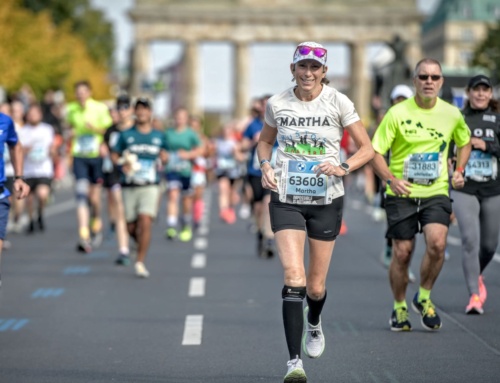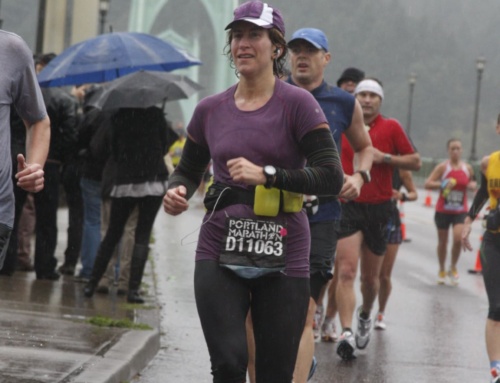Today’s Groover is Ariel Garl. She has two kids, ages 5 and 10, and struggles with severe asthma. Her recovery is an on-going process. Some running grooves aren’t as linear as a BAMR would like.
Remember: You can hear from all of our Groovers on Friday’s podcast.

Ariel’s back during her second race, um, back.
How did you lose your running groove?
Two years ago I was the fastest, strongest, leanest, and healthiest I had ever been. I was prepared to qualify for Boston. Then, for reasons that still escape me, I developed severe asthma. Despite being treated by one of the premier severe asthma specialists, I was frequently admitted to the Intensive Care Unit and placed on life support.
During the summer of 2016, I had a series of procedures to ablate (to basically burn out) some of the smooth muscle in my lungs. It’s not a cure but the hope is it will decrease the severity and frequency of my attacks. Though successful, I had complications. I developed a large blood clot in my arm and chest, had a vocal cord injury, infections, seizures, and debilitating weakness from medications and being critically ill. I also suffered a major neurologic event (a fancy term for we don’t really know what happened to my brain). I was left temporarily blind and without use of my left arm or leg for several days. It has improved greatly, but I am still slightly weaker on that side and have a tremor.

Ariel and her BRF after surgery
Though my asthma is still challenging, it has vastly improved. I occasionally get the gift of a few weeks in which I almost forget I have it. I manage it the best I can with the goal of living my life to the fullest, while accepting that I may end up back up in the ICU on occasion.
How did you get your groove back?
I am blessed with an amazing support system and also draw strength from my faith. My husband, children (ages 5 and 10), along with friends, church community, running buddies, a fabulous coach, phenomenal medical team, and a wonderful tribe of BAMRs, continues to help me recover and learn to live within my new normal.
In the beginning I was angry, frustrated, determined that I was not going alter my life at all. Over time that wasn’t possible — but I was determined that as long I was able (and my doctor allowed), I would run. Running was the only way I knew how to cope with this disease, the complications, and the unpredictable nature of it all.
While undergoing my lung procedures I had to stop running. When I returned to running my body had undergone some major insults. On by first run back, with my BRF by my side, I set out to cover the 5 mile “easy route” we always used to run. I made it 0.1 miles before I was forced to walk. However, we finished all 5 miles with similar intervals of 0.1 mile run with ½-1 mile walk. My first goal became to run all 5 miles, which took two months to accomplish.

Ariel with running buddies back on the road.
Over the last two years my outlook has changed a lot. I am more grateful for each day and footstep. I soak in the little moments life has to offer. When I can breathe easily throughout the day, and on my run, it is better than any gift I’ve ever received.
On the days I struggle, I choose to find the good. I started a gratitude journal and write down five things for which I am thankful each day. As much I am able, I continue this even when I am in the ICU. There is good all around if you just look for it.
I am also seeing a therapist. I have grieved with her and learned to settle into my new life. She gives me a safe place to cry and occasionally admit this really sucks. But she also helps me pick up the pieces and move forward.
I have a wonderful coach who has been with me through all of this. In challenging weeks, we will text daily and she gives me one workout at a time based on how I am feeling. She believes in my dreams. She supports me in the hard times and celebrates when I do things that should be impossible. She is also the voice of wisdom and reason and holds me back when needed.
More than anything, I refused to quit. No matter how hard it was, I focused on putting one foot in front of another. Shortly after my neurologic insult I was told to force my brain and body to communicate. So I ran, swam, and strength trained. When my body was wrecked by steroids and immobility from being on life-support, I would run as soon I was cleared to do so. I would run what I could and walk the rest.
Most often I celebrate what I can do. Boston still beckons. So I work each day on getting a little closer to a BQ.

At the Eau Claire half-marathon with BAMR Natalie. Ariel is wearing the green shirt she always wears in races now.
What advice would you give to others?
- Hang on when everything in you is screaming to let go, whether it is emotionally, physically, mentally — or all three. There are better days ahead and quitting will certainly never get you where you want to be.
- Allow yourself moments to grieve and be angry. Connect with those feelings of how unfair, uncertain, or hard this is. But do not allow yourself to live there. When I am struggling, I go somewhere I can be alone. I set a timer for 15 minutes and allow myself to really feel those intense emotions. I spend that time crying and experience that heartbreak, sorrow and disappointment. When the time is up, I dry my eyes, pick myself up, and move forward.
- Find your tribe and allow them to care for you. Those who I appreciate the most are the friends who stand with me when there is nothing they can do to fix the situation. Some of them live close and others are the tribe of BAMRs I met at the retreat in Little Rock a few years ago. They provide a safe place to let down without fear of judgment or misplaced advice. They watch my children when my husband needs a break. They sit sit with me in the ICU, even when I do not know they are there. They help me stay in the fight.
If you’re looking to get your groove back with a group of like-minded runners, there’s still time to Stride into the School Year. This five-week program is all about forward motion, fitness, accountability and community, not about training for a specific race. The workouts are one-size-fits-all, whether you’re a walker, run/walker, or runner, and whether you’re just starting to run, coming back to it after a decade off, or just need a little push to get you jump started again.







You are an inspiration. I wish I had the strength and tenacity that you do. I suffered from severe childhood asthma but luckily it has improved through much of my adult life. I wish you the best and hope to see you running Boston someday!
You are strong beautiful and your determination inspires me daily. It’s been an honor to get to know you better this past year. You definitely are a HERO!
Ever since I met you I knew you were an Overcomer. You’ve been an amazing encourager, runner, and most of all friend. I always appreciate the “realness” you provide when I am in a dark place with P’s health issues, though I am on the other side. You’ll never know how much o admire your strength to keep pushing! Love you bunches!!❤️
Ever since I met you 5 years ago, you never cease to amaze me! You are my heroic friend and you have taught me more than I can begin to list. Philippians 4:11
Thou are my true hero. You show me how to live, how to face life’s seemingly impossibile difficulties. You stand as an icon of courage in spite of deeply frightening, disturbing setbacks. You never lose you insight, you focus, your love or you delightful sense of humor. And here I am, so blessed to have you as my daughter. Godspeed, Ariel. Love, Mama
Wow. Just wow.